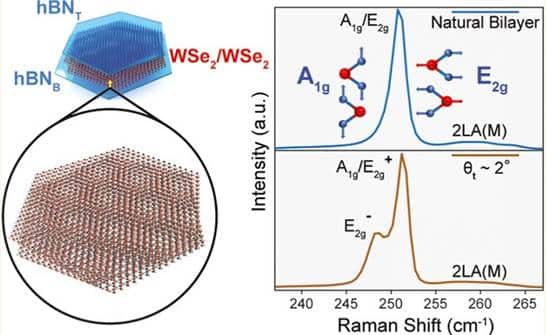Research Advances Engineering of Essential Materials for Emerging Technologies

A groundbreaking study from researchers at the Indian Institute of Science (IISc) in Bangalore has unveiled a novel method for manipulating phonon properties in two-dimensional materials. By adjusting the twist angles between layers of tungsten diselenide (WSe2) homobilayers, scientists can influence phonon hybridization and other essential characteristics. This advancement holds significant implications for the development of materials with customized thermal, optical, and electronic properties, crucial for the future of quantum technology.
Understanding Phonons and Their Importance
Phonons are collective excitations that occur in a periodic arrangement of atoms or molecules within condensed matter. They can be likened to ripples in a pond, created when a stone is dropped into the water. These energy waves travel through the crystal lattice as the atoms vibrate. The properties of phonons and their interactions are vital for the advancement of optoelectronic devices, which are essential for various technological applications. Researchers are actively exploring different techniques to control phonon properties to enhance device performance.
Innovative Research at IISc
The recent study published in ACS Nano highlights the intricate relationship between the periodic structures formed when two or more two-dimensional lattices overlap, known as moiré superstructures. The IISc team focused on WSe2 homobilayers, demonstrating how varying the twist angles between 1° and 7° can lead to significant changes in phonon modes. This research emphasizes the potential of manipulating phonon properties to engineer materials with tailored characteristics, which could pave the way for advancements in quantum technology.
Key Findings and Techniques
Utilizing Raman spectroscopy, the researchers observed that the twist angles in WSe2 homobilayers resulted in the splitting of phonon modes. They also noted unusual temperature-driven changes in Raman frequencies and line widths, particularly at low temperatures below 50 K. These findings underscore the complex interplay between electron-phonon coupling and phonon anharmonicity in twisted systems. The research utilized a Raman facility supported by the Fund for Improvement of S&T Infrastructure in Universities and Higher Educational Institutions (FIST) program, funded by the Department of Science and Technology.
Implications for Future Technologies
The implications of this research extend beyond basic science, opening new pathways for the design of advanced materials tailored for photonic, quantum, and electronic applications. By controlling phonon properties through twist angles in two-dimensional materials, scientists can create devices with enhanced performance and efficiency. This breakthrough could significantly impact the fields of quantum computing and optoelectronics, leading to the development of next-generation technologies that rely on finely tuned material properties.
Observer Voice is the one stop site for National, International news, Sports, Editor’s Choice, Art/culture contents, Quotes and much more. We also cover historical contents. Historical contents includes World History, Indian History, and what happened today. The website also covers Entertainment across the India and World.
Follow Us on Twitter, Instagram, Facebook, & LinkedIn

